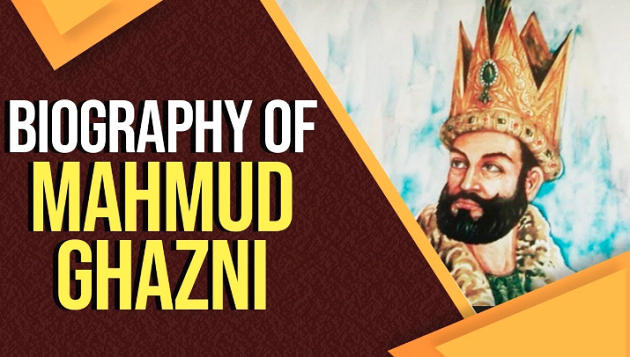Table of Contents
MUHAMMAD OF GHAZNI
- Mahmud of Ghazni ( November 971 – 30 April 1030) was the first independent ruler of the Ghaznavid dynasty, ruling from 998 to 1030.
- At the time of his death, his kingdom had been transformed into a extensive military empire, which extended from northwestern Iran proper to the Punjab in the Indian subcontinent,Khwarazm in Transoxiana, and Makran.
- He was the first ruler to hold the title Sultan (“authority”), .During his rule, he invaded and plundered parts of the Indian subcontinent (east of the Indus River) seventeen times.
EARLY LIFE
- Mahmud was born in the town of Ghazni in the region of Zabulistan (now present-day Afghanistan) on 2 November 971.
- His father, Sabuktigin, was a Turkic slave commander (ghilman) who laid foundations to the Ghaznavid dynasty in Ghazni in 977.
- Mahmud’s mother was the daughter of an Iranian aristocrat from Zabulistan.Not much about Mahmud’s early life is known.
SULTAN
- Sabuktigin died in 997, and was succeeded by his son Ismail as the ruler of the Ghaznavid dynasty.
- Mahmud shortly revolted, and with the help of his other brother, Abu’l-Muzaffar, the governor of Bust, he defeated Ismail the following year at the battle of Ghazni and gained control over the Ghaznavid kingdom.
- Mahmud initiated the first of numerous invasions of North India. On 28 November 1001, his army fought and defeated the army of Raja Jayapala of the Kabul Shahis at the battle of Peshawar.
SULTAN
- In 1002 Mahmud invaded Sistan and dethroned Khalaf ibn Ahmad, ending the Saffarid dynasty.From there he decided to focus on Hindustan to the southeast, particularly the highly fertile lands of the Punjab region.
- Mahmud’s first campaign to the south was against an Ismaili state first established at Multan in 965 from the Fatimid Caliphate.
- At this point, Jayapala attempted to gain revenge for an earlier military defeat at the hands of Mahmud’s father, who had controlled Ghazni in the late 980s and had cost Jayapala extensive territory.
RAIDS ON INDIAN SUBCONTINENT
- Following the defeat of the Indian Confederacy, after deciding to retaliate for their combined resistance, Mahmud then set out on regular expeditions against them, leaving the conquered kingdoms in the hands of Hindu vassals and annexing only the Punjab region.
- In 1001 Mahmud of Ghazni first invaded modern day Afghanistan and Pakistan and then parts of India.
- In 1005 Mahmud of Ghazni invaded Bhatia (probably Bhera), and in 1006 he invaded Multan, at which time Anandapala’s army attacked him. In 1014 Mahmud led an expedition to Thanesar. The next year he unsuccessfully attacked Kashmir.
RAIDS
- In 1018 he attacked Mathura and defeated a coalition of rulers there while also killing a ruler called Chandrapala. In 1021 Mahmud supported the Kannauj king against Chandela Ganda, who was defeated.
- Mahmud besieged Gwalior, in 1023, where he was given tribute. Mahmud attacked Somnath in 1025, and its ruler Bhima I fled. The next year, he captured Somnath and marched to Kachch against Bhima I. That same year Mahmud also attacked the Jat people of Jud • The Indian kingdoms of Nagarkot, Thanesar, Kannauj, and Gwalior were all conquered and left in the hands of Hindu, Jain, and Buddhist kings as vassal states
DEATH
- The last four years of Mahmud’s life were spent contending with the influx of Oghuz and Seljuk Turks from Central Asia and the Buyid dynasty.
- In 1040, at the Battle of Dandanaqan, they decisively defeated Mahmud’s son, Mas’ud I, resulting in Mas’ud abandoning most of his western territories to the Seljuks.
- Sultan Mahmud died on 30 April 1030. His mausoleum is located in Ghazni, Afghanistan.






















 WhatsApp
WhatsApp